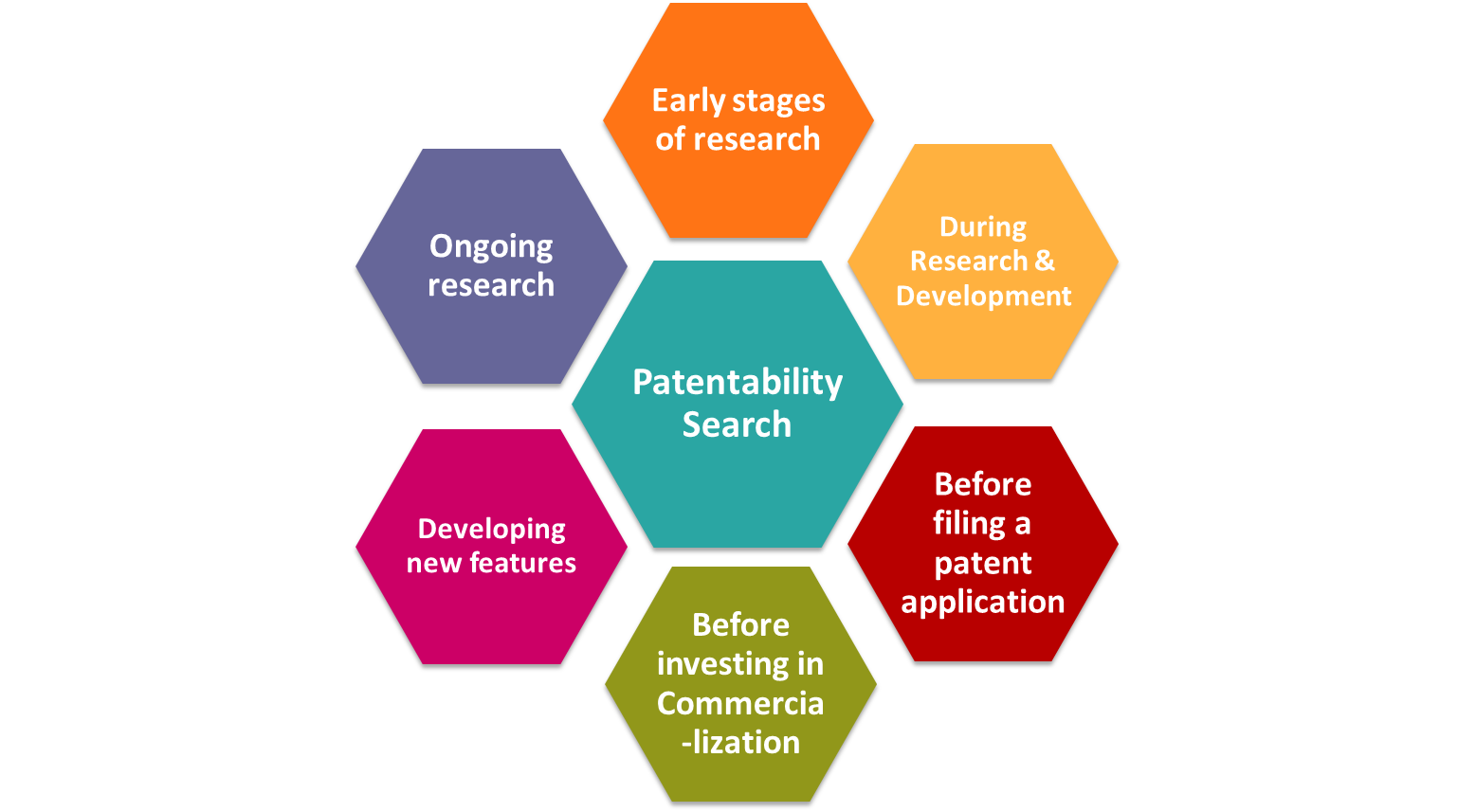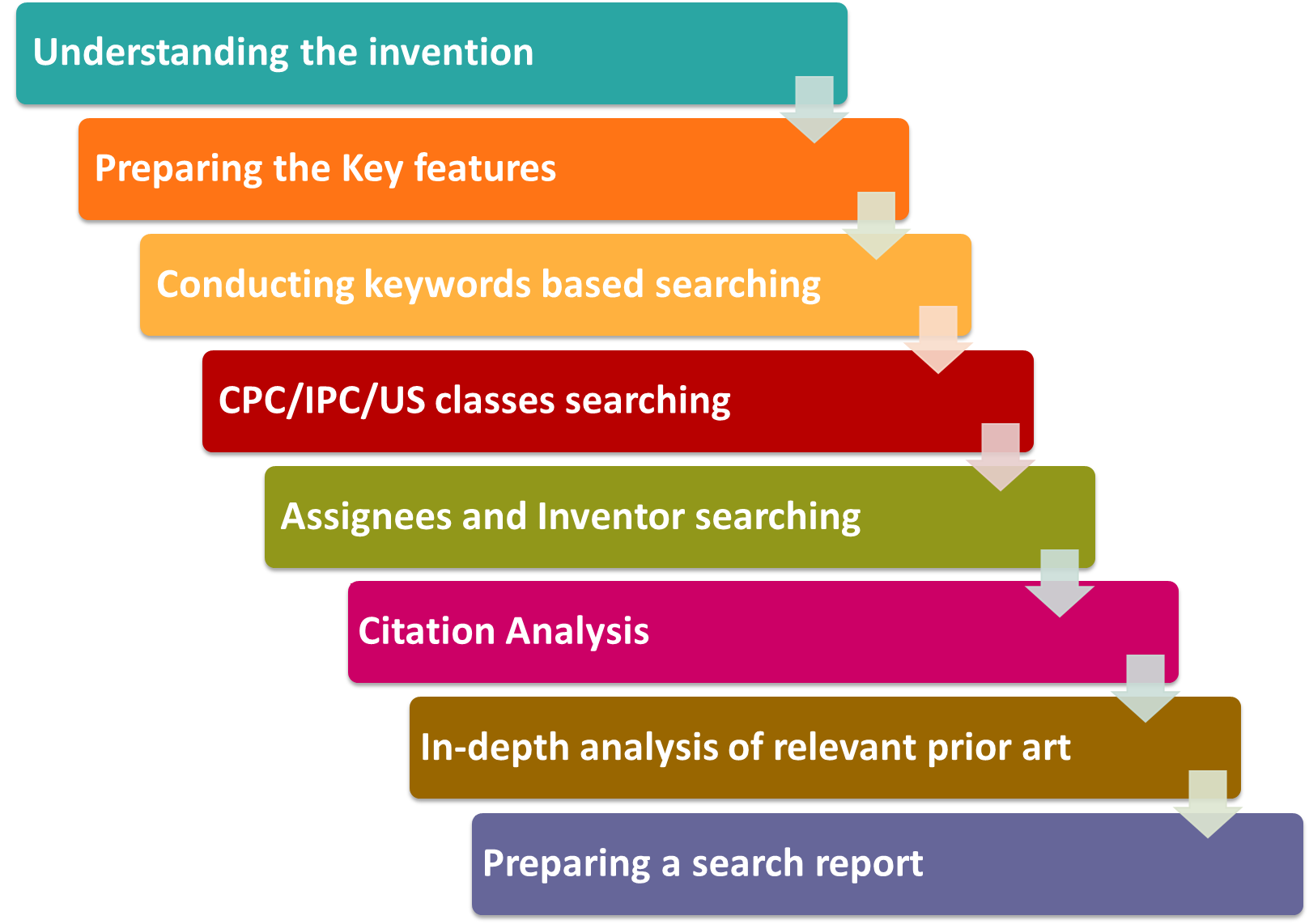It may be just an innovative thought you came up with just sitting in your lawn or any organization having an established infrastructure, patents are the foremost and strongest form of protection for your inventions. A patent is an exclusive right granted for an invention. It provides with legal protection for their invention. How would you know if your innovative thought is new or simply a repeat of an existing one?
The answer to this is “Patentability Search”.
A patentability search is systematic analysis conducted to analyze weather the invention meets the criteria for the patent protection, especially novelty and non-obviousness. The search identifies the relevant prior art references covering the aspects same as that of the invention. The search determines whether or not the patent is eligible for grant. If not, you can modify the invention according to the prior art results identified in the search.
The search involves a thorough analysis of both patent and non-patent literature, to determine the uniqueness of the invention to make sure it is entirely new and an inventive step of the invention so that it would not be found obvious to the person with ordinary skills in the art. It allows you to make an informed decision about the patent protection of the invention. If the invention doesn’t seem to be patentable, you can save lot of money for filing and drafting the patent application and work on the invention to meet the criteria of patentability.

Filing a patent and prosecuting a patent is highly expensive, it is always a better idea to conduct a patentability search prior to filing and prosecuting the patent.
1. Is patentability search really necessary?
Patent examiners dedicate significant time examining every patent application. If they uncover any prior art that proves the lack of novelty, non-obviousness, or utility of your invention, rejection becomes inevitable. A patentability search helps you identify relevant prior art early, avoid surprises, strengthen your application, and stay updated.
Some of the reasons to conduct a patentability search are as follows:

2. Timing is everything
A patentability search could be conducted at various stages, from an initial idea to its execution as a final product. Some of them are as follows:

- Early stages of research: A patentability search should be conducted during the initial phases of research to ensure that you are not working on a pre-existing idea.
- During Research and Development: A patentability search should be conducted during the research and development phase of the invention to keep yourself updated.
- Before filing a patent application: A patentability search should be conducted before initiating the filing procedure for a patent application. It saves both time and money from procedure of filing if any relevant prior art is identified beforehand.
- Before investing in Commercialization: A patentability search should be conducted before you invest for commercialization to protect yourself from further legal actions.
- Developing new features: A patentability search should also be conducted while developing a new feature to ensure the novelty of the feature.
- Ongoing research: A patentability search may be conducted even after obtaining a patent to keep yourself updated with relevant prior art references.
3. Avoid the red flags
- No date barriers: The term novel indicates that the invention should be entirely new before filing a patent application. The addition of any date restriction may restrict the scope of the search. Hence, it should be avoided.
- No borders in search/Global prior art: The novelty and non-obviousness are global parameters, no jurisdictional restrictions must be used during the search as any relevant document in any form is considered as prior art irrespective of its language or jurisdiction.
- All documents matter: Similar to date and jurisdiction restriction, no document type restriction should be used as any form of disclosure or a document in the form of thesis, blogs, posters, articles, presentation, etc. (as mentioned in Section V) are also considered as prior art.
4. Your patentability search guide
In order to conduct a patentability search, the following steps should be taken:

- 1. Understanding the invention: Before initiating a patentability search, it is very important to thoroughly understand the invention. It involves the identification of possible uniqueness in the invention by comparing the invention to the already existing technology of the domain.
- 2. Preparing the Key features: After the complete understanding of the invention, multiple key features are prepared from the invention. This step helps in formulation of key words and set the right search strategies. The synonyms, similar phrases used to describe similar technologies or concepts, and technical terms are also identified.
- 3. Conducting keywords based searching: The search is initiated with broad searches and then narrowing them, if required by adding keywords from the above key features. Multiple strings based on different logics are run and relevant prior art documents from the search results are identified on the basis of key features prepared, filtering out the non-relevant prior art. These strategies are applied for both patent as well as non-patents prior art.
- 4. Expanding the search with relevant CPC/IPC/US classes: All the relevant classes are identified and classification searching is done to identify more precise relevant prior art references.
- 5. Assignees and Inventor searching: The assignees and inventors of all the identified relevant prior art are noted and separate search strings are prepared with both assignees and inventors. Identification of any new relevant prior art references is done.
- 6. Citation Analysis: The forward and backward citations of all the relevant results are run and analyzed.
- 7. In-depth analysis of relevant prior art: After completing the searching, deep understanding is developed by analyzing all the relevant patent and non-patent documents identified that are most similar to the invention. Best results out the relevant prior art references are sorted.
- 8. Preparing a search report: The identified relevant prior art references are compiled into one comprehensive report, which also includes search strategies. The report serves as a documented record of the patentability assessment.
5. Hidden Trails to Prior Art
Prior art can be identified through various techniques. Some of them would even surprise you. Some of these are uncommon but very valuable including:

- 1. Search Engines: The identification of results also depends upon which search engine is being used. Different search engines fetch variable results for the same query. While using search engines like Google, Bing, etc., you can use search operators such as AND, OR, (), “”, etc.
- 2. Trade Show Presentation: The presentations displayed in trade shows may include new ideas/concepts which can be good prior art references.
- 3. University Portals: You can also use various university portals to find research papers, articles, posters, theses, etc., which might not be present on other databases.
- 4. Image Searching: You can search in the “Images” section of the search engine to look for prior art similar to your invention. You can also identify prior art references even if they only involve general concepts that someone has uploaded.
- 5. Video Searching: You can also search in the “Videos” section of the search engine and other sites such as YouTube.
- 6. National Databases: National databases of many countries provide a portal to search for prior art references in their specific country. You can identify country-specific patents, as sometimes they may not be present on other databases.
- 7. Social Media: You can sometimes find prior art references on social media platforms such as Instagram, Facebook, X, Threads, etc.
- 8. Shopping Sites: When you are looking for a product, it’s always a good idea to go for shopping site searching to know if it is already present in the market.
- 9. Traditional Literature: You can also identify prior art references from ancient literature books of different countries like India, China, etc., as well as from traditional databases like the Traditional Knowledge Digital Library (TKDL).
6. Case Study
A patentability search was conducted for a non-invasive skin inflammation detection device.
6.1 Background & Objective
A company developed a non-invasive skin inflammation detection device, that was designed to identify conditions like redness, swelling, internal damage, and vasodilation with the help of detection device in the form a patch/Band-Aid. To know about the patentability of their invention, they needed us to conduct patentability search on the device.
6.2 Patentability Search Process
- 1. Understanding the invention: The patentability search began with in-depth understanding of detection device focusing on non-invasive nature of the detection device.
- 2. Prior Art Search: A worldwide search was conducted across multiple patent databases, journals, university portals, and articles to identify existing prior art references related to similar skin inflammation detection techniques, any non-invasive detection device for skin inflammation, patch detecting skin inflammation, algorithm used for detecting the skin condition, etc.
- 3. Assessment criteria: Prior art were evaluated on the basis of the features of the invention and most relevant results were filtered out.
- 4. Results: The results revealed prior art in the use of generic detection devices but their mode of detection was very different from what was given in the invention.
6.3 Outcome of the Patentability Search
The company was able to file a strong set of claims of their invention.
WHAT TO KNOW ABOUT THE PATENTABILITY OF YOUR INVENTION?
7. Frequently Asked Questions
Question: What should I do if I'm concerned that someone else might file a patent for the same invention before I do?
Answer: You can file a provisional application to get priority (earliest priority date) for your invention. This will give an edge over your competitors while filing a patent.
Question: Can I skip the patentability search before filing a patent?
Answer: It is always advisable to conduct a patentability search before filing a patent as it saves a lot of time, cost, and work from the filing procedure.
Question: What do I gain from investing in patentability search?
Answer: Our patentability search helps you identify most relevant prior art according to your invention which helps you to assess the novelty of the invention. Our patentability search helps you to make an informed decision about gaining protection for your invention.